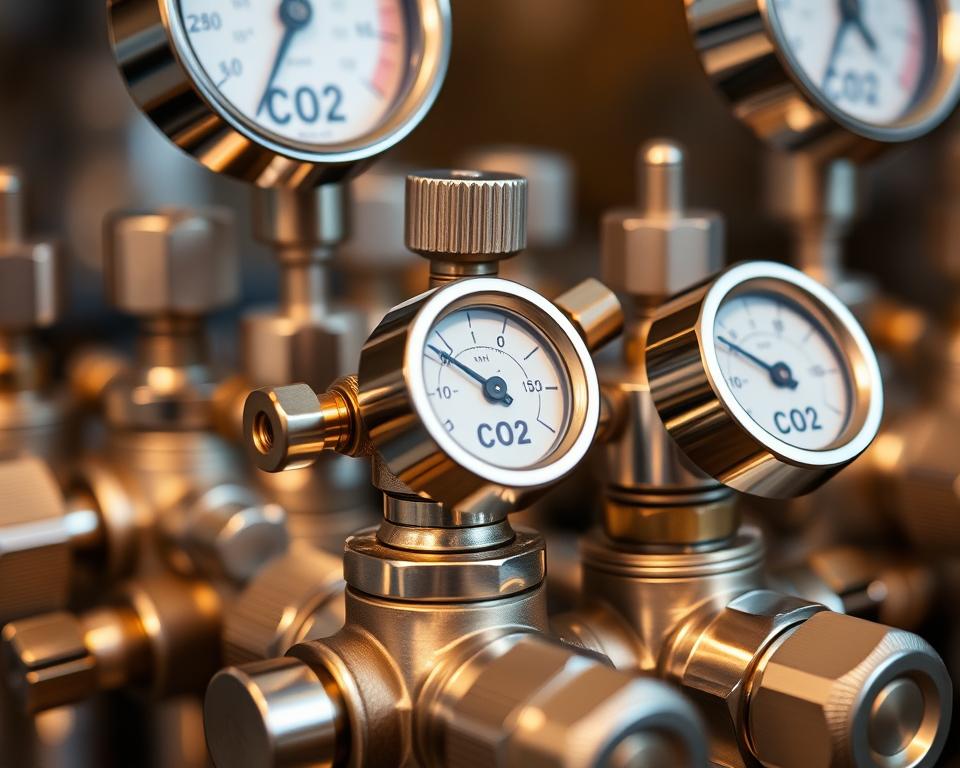CO2 Regulator Fittings – Vital Guide & Tips
Did you know that primary regulators in CO2 systems lower tank pressure from 800-900 psi to a more controllable 10-30 psi? This not only demonstrates the efficiency of CO2 regulator fittings but underscores their vital role in securing a flawless pour. They are essential in settings like kegerators, aquariums, and industrial applications. Grasping CO2 tank fittings is fundamental for optimal performance and consistency.
CO2 regulator fittings greatly influence the excellence and taste of carbonated beverages. Choosing superior CO2 regulator fittings can ensure steady gas pressure, avoiding over or under-carbonated beer problems. It is crucial to choose first-rate CO2 fittings from reputable sources like Installation Parts Supply. This guarantees durability and performance. We examine various fitting options, setup tips, care recommendations, and decision-making tactics for specific needs.
Vital Takeaways
- Key regulators are essential for reducing high CO2 tank pressure for optimal serving.
- Diverse beer styles require unique carbonation settings to attain the finest flavor.
- Steady gas pressure is imperative to avert excessively or insufficiently carbonated beverages.
- Additional regulators are vital when dispensing multiple kegs at diverse pressures.
- Choosing premium fittings from reputable brands can boost system reliability.
Getting Started with CO2 Regulator Fittings
CO2 regulator fittings play a key role in regulating carbon dioxide flow and pressure across various sectors. These include beverage dispensing, fish farming, and healthcare applications. They regulate the CO2 pressure from a high range (800 to 1000 PSI) to a more regulated range (1 to 40 PSI). Such regulation is key to the consistent performance of CO2-dependent devices.
The main parts of CO2 regulator fittings comprise the regulator along with the shut-off valve. The regulator controls appropriate pressure levels, while the shut-off valve supplies hands-on gas flow control. A remarkable safety feature is the check valve. Its function is to avert back-siphoning, preserving the system’s integrity. In aquatic setups, securing stable pH levels through precise CO2 delivery is vital. Tools such as bubble counters and pH controllers play a significant role in this process, helping to ensure optimal plant conditions.
Choosing reliable CO2 regulator fittings is vital for optimal performance in different environments. When selecting fittings, it’s crucial to assess the suitability of materials with CO2. For example, silicone tubing might allow gas to escape, which could cause losses. Choosing premium needle valves can prevent issues such as ‘end of tank dumps.’ This guarantees safety and preserves steady CO2 flow.
The Function of CO2 Regulator Fittings Function
CO2 regulator fittings play a pivotal role in the efficiency and security of CO2 systems. They support steady pressure, vital to proper carbonation in beverages. High-pressure CO2 tanks, containing 800 to 900 psi, need their pressure reduced to a practical 10-30 psi. Such pressure lowering is essential for serving at the optimal carbonation levels. Primary regulators, vital elements of CO2 regulator fittings, make possible this process. They often come with one or two gauges to monitor the gas pressure.
Regarding serving beer, the performance of these fittings is of utmost importance. Inconsistent pressure can spoil the integrity of the pour. It can lead to beer that’s either over-carbonated or lacking carbonation. Given that distinct beer types necessitate specific carbonation levels, like stouts needing less than lagers, additional regulators play a vital role. They permit fine-tuning based on the particular demands of each keg.

For portable dispensing, such as with miniature 74 gram CO2 tanks, mobile beer regulators are perfect. They enable dispensing with a minimal arrangement, capably delivering a 1/4 barrel. Opting for dependable CO2 system regulator fittings is imperative. Manufacturers such as Taprite are famous for dependable regulators, enhancing the beer dispensing process.
| Regulator Type | Pressure Range | Application |
|---|---|---|
| Primary Regulator | 10-30 | Applied in typical beer service |
| Dual Gauge Regulator | 0-60 | Shows both tank and output pressures |
| Secondary Regulator | Depends | Ideal for serving multiple kegs |
| Mobile Beer Regulator | 10-14 | Ideal for on-the-go serving from small tanks |
A deep understanding of the roles and details of CO2 regulator fittings can enhance a serving setup. Regularly checking pressure gauges and fittings secures that the system operates seamlessly. This proactive approach ensures superior service quality.
Types of CO2 Regulator Fittings
As you select CO2 regulator fittings, it’s important to understand the varieties available for maximum efficiency in different scenarios. The primary types are single gauge and dual gauge regulator fittings. Each fulfills specific roles, addressing the demands of different environments from entry-level home brewing to advanced industrial operations.
Single Gauge Regulator Fittings
Designed for entry-level use, single gauge regulator fittings are ideal for manual adjustment needs. They feature a sole gauge indicating the gas’s output pressure. Perfect for small-scale projects like home kegerators or minor breweries, they offer a straightforward approach. Brands such as Brewmaster and Fermentap stand out for providing user-friendly and reliable solutions.
Dual Gauge Regulator Fittings
Dual gauge regulator fittings are equipped to offer more detailed monitoring by showing both output and tank remaining pressure. They are critical for advanced operations, including industrial brewing. This double indication helps users avert issues like keg explosions or gas leaks. For those demanding higher accountability, options including KOMOS and Taprite offer a wide selection of dual gauge options.
| Variety | Benefits | Ideal Application | Notable Brands |
|---|---|---|---|
| Single Gauge Regulator Fittings | User-friendly, straightforward adjustments | Entry-level applications | Brewmaster & Fermentap |
| Dual Gauge Regulator Fittings | Enhanced monitoring, precision control | Professional and multi-keg systems | KOMOS / Taprite |
Deciding on the Right CO2 Regulator Fittings for Your Requirements
Selecting the ideal CO2 regulator fittings necessitates key factors. These factors boost the CO2 system’s functionality and integrity. First, assess the pressure range that meets your application, confirming the fittings support the required pressure levels. You must verify compatibility with CO2 sources like CGA-320 valves for a smooth connection. Also, prioritize durability to prevent leaks and malfunctions in your CO2 system.
Important Aspects in Choosing Fittings
- Operating Pressure: The fittings should manage your system’s PSI needs.
- Build Quality: Choose corrosion-resistant materials, such as stainless steel, for longevity.
- Fit: Ensure the fittings are compatible with your CO2 sources.
- Ease of Installation: Seek out designs that simplify installation.
Trusted Brands for Premium CO2 Fittings
Prioritizing trusted brands is vital for optimal performance and reliability. Installation Parts Supply is noted for supplying premium CO2 regulator fittings. Their offerings strike a balance between quality and cost, suiting both hobbyists and professionals. The Milwaukee MA955 solenoid, costing approximately $40 CAD, is praised for its performance and dependability. Additionally, the Aqualabs regulator and the Dici regulator with a bubble counter are economical, costing $50 to $60 CAD on Amazon. These brands are superior options for upgrading your aquarium system.
Installation Advice for CO2 Regulator Fittings
Installing CO2 regulator fittings requires a keen attention to fine details and adherence to essential safety measures. An accurate installation ensures that the system works efficiently. It also safeguards against leaks that could pose safety risks. To achieve proper installation of CO2 regulator fittings, follow these recommendations:
- First, inspecting the control valve. Make sure it is turned off before continuing with installation, as this prevents accidental gas flow during the installation process.
- Ensure correct sealing on the threaded interfaces. Teflon tape serves as an effective solution to ensure a secure fit without any leak risk.
- Configure the CO2 regulator to the proper pressure, which is essential for optimal carbonation and preventing excessive pressure that could damage your system.
- Following installation, vent the gas step-by-step to enable precise gauge readings and clear the system of air pockets.
- After installation, conduct a thorough inspection for any signs of leaks. Using a soap solution will reveal leaks, ensuring your system operates safely.
By adhering to these installation tips, you can greatly enhance both the functionality and integrity of your dispensing system.
CO2 Regulator Parts: Maintenance and Troubleshooting
For optimal CO2 regulator performance, routine care and early troubleshooting are key. Frequent checks help spot problems early on. Leak detection is critical. A soap test can easily spot leaks, where bubbles indicate a need for repair.
Correctly securing internal parts is essential, with a 7/8 socket wrench recommended for a secure fit. Keeping the regulator’s integrity ensures its long life. After putting the bonnet back, 75 foot/lbs of torque is recommended. After repair, the regulator should read above 40 PSI. Sometimes, an additional 1/4 turn is required for proper pressure.
Improper installation or missing washers often cause leaks, draining CO2 tanks quickly. For beer regulators, pressure relief valves typically engage below 60 PSI. However, certain units might release at elevated pressures. Failures in diaphragms or cartridges commonly require rebuilding the regulator.
Brands differ in their operational characteristics. The Milwaukee MA957, though popular, is sometimes criticized for needle valve problems and comes with a 6-month warranty. A 5-year warranty from CMBecker underscores product reliability.
Timely maintenance increases the longevity of CO2 systems. Familiarity with your regulator’s parameters, for instance Taprite’s 0-50 PSI, helps with repairs. Taprite regulators handle various beverage pressures, showcasing adaptability.
Economical vs. Premium CO2 Regulator Fittings
Choosing between affordable CO2 fittings and premium CO2 regulator fittings hinges on their price. Entry-level options are available from $20, whereas premium products often begin at $200. For instance, a cost-effective CO2 setup with a simple regulator connected to a standard 5 lb cylinder could be priced between $150 to $175. Alternatively, a top-quality CO2 system could cost up to $625, subject to the brand and quality level.
A system’s reliability is mostly determined by its component quality. It is commonly observed that premium regulators offer exact pressure modulation, especially for tanks under 10 gallons. Additionally, a majority of users prefer paying more for complete systems, prioritizing convenience and guaranteed quality. Assembly by companies versus individual manufacturing can lead to significant price differences.
There’s potential for savings when individuals opt to buy parts separately and assemble themselves by 20-30% compared to buying ready-made kits. Component costs, such as those for solenoids and metering valves, vary widely. Solenoids can cost between $20 and $50, while the cost of metering valves spans from $17 to beyond $200, depending on their quality and function.
The cost of a 5 lb aluminum CO2 tank, around $60, contributes to the total system expense. Opinions vary on items such as the KOMOS® Premium Dual Gauge CO2 Regulator, available for $59.99. It has an operating pressure range up to 60 PSI and an unspecified maximum flow rate. This regulator also comes with a pressure relief valve that triggers at 65 PSI.
Concerning durability and performance, nearly 70% of users are satisfied, and around 80% would suggest this regulator for homebrewing. Despite this, there are concerns such as slow leaks, experienced by 10% of users. The willingness to invest more stems from a desire for dependable performance, an essential factor in choosing between budget-friendly and premium CO2 fittings and regulators.
The Final Word
Choosing the right CO2 regulator fittings is crucial for your system’s efficiency, safety, and cost-effectiveness. We explained key considerations, including types of CO2 regulator fittings and criteria for selection. Selecting an appropriate regulator is vital for maintaining desired carbonation in draft beer, ensuring dependable operation over time.
While premium fittings may cost more initially, they offer enhanced durability and simpler maintenance. Reputable brands such as Airgas, Taprite, and Micromatic deliver exceptional reliability. They help meet the unique demands of different users, ensuring long-term satisfaction and performance.
It is recommended to consult trusted suppliers like Installation Parts Supply when setting up or upgrading a CO2 system. Obtaining high-quality products along with expert guidance can significantly boost your system’s performance. Quality fittings are an investment in the efficiency of both homebrewing setups and commercial operations.
Frequently Asked Questions
What do CO2 regulator fittings do and why are they important?
CO2 regulator fittings manage the flow and pressure of CO2 in systems such as kegerators, aquariums, and other applications. They are essential in ensuring the system’s efficiency and security by controlling CO2 levels.
Which types of CO2 regulator fittings exist?
The key types are single gauge and dual gauge regulator fittings. For simple setups like home kegerators, single gauge fittings offer basic, manual control. Dual gauge fittings provide detailed pressure data and are well-suited for commercial and advanced applications.
What factors should I consider when choosing CO2 regulator fittings?
Selecting the right CO2 regulator fittings involves considering the pressure needs, fit with your CO2 supply, and build standards. Focus on reliability and secure design to avoid leaks and ensure efficient system functioning.
What are some recommended brands for high-quality CO2 fittings?
Brands like Installation Parts Supply offer top-quality CO2 regulator fittings. Selecting well-known brands ensures both safety and efficiency.
What are the best practices for installing CO2 regulator fittings?
For successful installation, ensure all connections are tight to avoid leaks. Adjust the pressure appropriately and vent gas in order to achieve accurate readings. Follow professional recommendations for optimal setup.
What upkeep is required for CO2 regulator fittings?
Routine care is key to keeping your system in peak condition. This includes checking for leaks, making necessary pressure adjustments, and troubleshooting common issues. Following these guidelines maintains system performance.
Are premium CO2 regulator fittings worth the investment?
Without a doubt, premium fittings from trusted manufacturers can reduce overall costs by lowering maintenance and replacement expenses. They offer better reliability and boost your system’s overall functionality.

